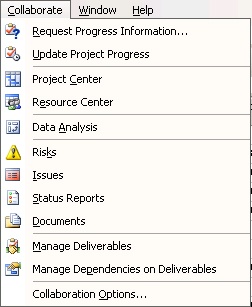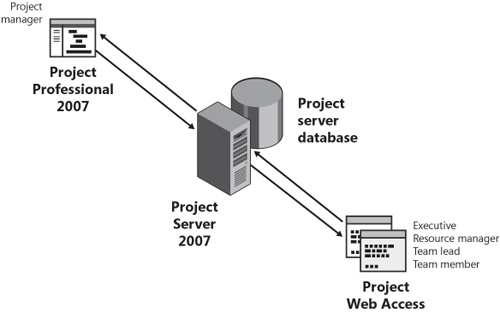There are different ways to look at the various pieces that contribute to the Project Server enterprise project management solution. You can look at it from an architecture standpoint or from a data flow standpoint. In this section, however, we’ll review the components of Project Server enterprise project management from the point of view of the applications that the enterprise users interact with. These applications are Project Server, Project Professional, and Project Web Access.
Note
For system requirements for Project Server and the enterprise features, see Appendix A.
Project Server is the server that manages all data associated with your enterprise projects, portfolios, and programs. It also manages the information related to user access, security settings, administrative settings, and so on.
Project Server sits atop the database that stores all project information generated either from Project Professional or Project Web Access (see Figure 20-7). This project database is powered by Microsoft SQL Server
Figure 20-7. Project Server sits atop the project database, works with information from Project Professional, and provides a view to project information through Project Web Access.
In Microsoft Project 2003, the scheduling engine was available only in the Project Professional 2003 clients. However, Project Server 2007 includes a scheduling engine to enable project updates.
Project Server provides queuing services for efficient processing even at peak times. It also provides eventing services to enable updating of the database from either Project Professional or Project Server as well as integration with other applications. Project Server is built by using the Microsoft .NET Framework 2.0.
An available option is Project Portfolio Server, which works with Project Server to provide project portfolio management tools and services.
Project Server uses the Project Server Interface (PSI) as the application program interface (API), which is the means through which Project Professional and Project Web Access have a view into and interact with Project Server. The Project Server Interface enables tasks, resources, assignments, and entire projects to be manipulated—created, viewed, edited, or deleted programatically. The Project Server Interface replaces the Project Data Server (PDS) that was used in Project Server 2003.
In addition, developers can use the Project Server Interface to create methods for interacting with line of business applications (for example, human resources, procurement, and accounting systems) and other third-party applications.
As the project management application, Project Professional is the primary client of Project Server and the major source of project data, including projects, tasks, resources, assignments, scheduling dates, costs, and tracking information that is served by the project server.
When Project Professional is part of an enterprise project management solution, collaboration options become available (see Figure 20-8). These options make it convenient for project managers to move back and forth between the Project Professional environment and the Project Web Access environment.
Figure 20-8. When Project Professional is connected to a project server, the Collaborate menu becomes available.
Another client of Project Server is Microsoft Internet Explorer. Other clients can include Microsoft Office Outlook, line of business applications, and third-party applications.
Project Web Access is the Web-based source for project data, including tasks, resources, assignments, scheduling dates, costs, and tracking information. Project Web Access is a Web site running on at least Internet Explorer 6.0 with unique capabilities to work specifically with Project Server 2007 and display targeted project data. It is the view into the project server and the underlying project database.
This Web site typically lives on your organization’s intranet or extranet and is accessed by project team members. A view into Project Web Access can also be accessed from within Project Professional.
Project Web Access is an application of Windows SharePoint Services 3.0, which provides the administrative and user interface framework, the infrastructure for user management, logon capabilities, team collaboration, and integration with the reporting features of Project Server.
Here’s a simplified description of the sequenced interaction between the three Microsoft Project components in a little more detail:
Project data generated by either Project Professional or Project Web Access is saved to a project database that’s part of your project server architecture.
When projects are published (rather than simply saved), their data is saved in the appropriate database: the working or draft database, the published database, or the reporting database. Whenever a project is saved, it is saved to the draft database. Whenever a project is published, it is also saved to the published database. The data in the published database is then transformed and added to the reporting database for analysis purposes.
When a user needs to see project, task, resource, or assignment information in Project Web Access or Project Professional, Project Server calls this information up from the appropriate database and displays it in pages created through the Project Server Interface (see Figure 20-9).



